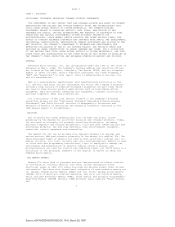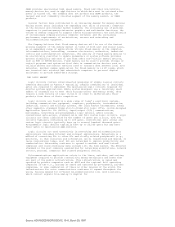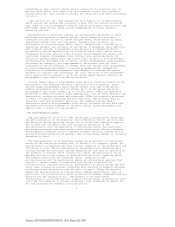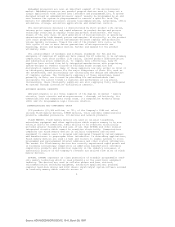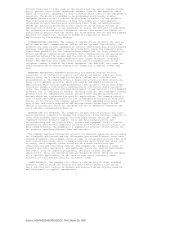AMD 1996 Annual Report Download - page 17
Download and view the complete annual report
Please find page 17 of the 1996 AMD annual report below. You can navigate through the pages in the report by either clicking on the pages listed below, or by using the keyword search tool below to find specific information within the annual report. Distributors typically maintain an inventory of the Company's products.
Pursuant to the Company's agreements with distributors, AMD protects its
distributors' inventory of the Company's products against price reductions, as
well as products that are slow moving or have been discontinued. These
agreements, which may be canceled by either party on a specified notice,
generally contain a provision for the return of the Company's products in the
event the agreement with the distributor is terminated. The price protection
and return rights AMD offers to its distributors may materially adversely
affect the Company.
AMD derives a substantial portion of its revenues from its sales
subsidiaries located in Europe and Asia Pacific. AMD subsidiaries have offices
in Australia, Belgium, Brazil, Canada, China, Finland, France, Germany, Hong
Kong, Italy, Japan, Korea, Singapore, Sweden, Switzerland, Taiwan and the
United Kingdom. (See Note 11 of Notes to Consolidated Financial Statements
contained in the 1996 Annual Report to Stockholders.) The international sales
force also works with independent sales representatives and distributors with
offices in approximately 37 countries, including those where AMD has sales
subsidiaries. The Company's international sales operations entail political
and economic risks, including expropriation, currency controls, exchange rate
fluctuations, changes in freight rates, and changes in rates and exemptions
for taxes and tariffs.
RAW MATERIALS
Certain of the raw materials used by the Company in the manufacture of its
products are available from a limited number of suppliers. For example,
several types of the integrated circuit packages purchased by AMD, as well as
by the majority of other companies in the semiconductor industry, are
principally supplied by Japanese companies. Shortages could occur in various
essential materials due to interruption of supply or increased demand in the
industry. If AMD were unable to procure certain of such materials, it would be
required to reduce its manufacturing operations which could have a material
adverse effect on the Company. To date, AMD has not experienced significant
difficulty in obtaining necessary raw materials.
ENVIRONMENTAL REGULATIONS
The failure to comply with present or future governmental regulations
related to the use, storage, handling, discharge or disposal of toxic,
volatile or otherwise hazardous chemicals used in the manufacturing process
could result in fines being imposed on the Company, suspension of production,
alteration of the Company's manufacturing processes or cessation of
operations. Such regulations could require the Company to acquire expensive
remediation equipment or to incur other expenses to comply with environmental
regulations. Any failure by the Company to control the use, disposal or
storage of, or adequately restrict the discharge of, hazardous substances
could subject the Company to future liabilities and could have a material
adverse effect on the Company.
INTELLECTUAL PROPERTY AND LICENSING
AMD and its subsidiaries have been granted over 1,165 United States patents,
and over 1,327 patent applications are pending in the United States. In
certain cases, the Company has filed corresponding applications in foreign
jurisdictions. The Company expects to file future patent applications in both
the United States and abroad on significant inventions as it deems
appropriate.
On January 11, 1995, the Company and Intel reached an agreement to settle
all previously outstanding legal disputes between the two companies. As part
of the settlement, in December 1995, the Company signed a five-year,
comprehensive cross-license agreement with Intel which expires on December 31,
2000. The agreement provides that after December 20, 1999, the parties will
negotiate in good faith a patent cross-license agreement to be effective
January 1, 2001. Effective January 1, 1996, the new agreement gives the
Company and Intel the right to use each others' patents and certain
copyrights, including copyrights to the x86 instruction sets but excluding
other microprocessor microcode copyrights beyond the Intel 486(TM) processor
code. The cross-license is royalty-bearing for the Company's products that use
certain Intel technologies. The Company is required to pay Intel minimum non-
refundable royalties during the years 1997 through 2000.
13
Source: ADVANCED MICRO DEVIC, 10-K, March 20, 1997


